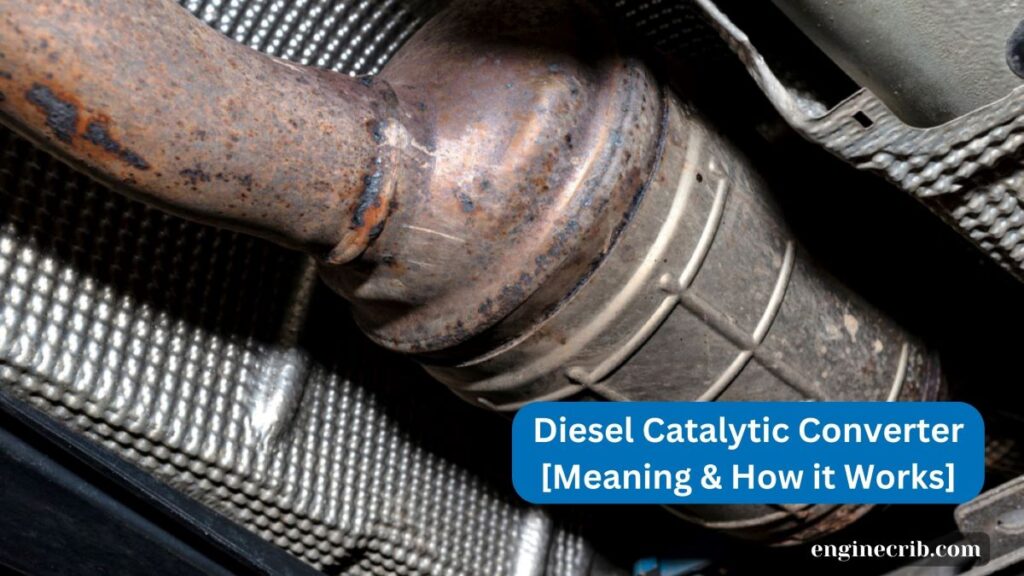Diesel engines have been a popular choice for powering heavy-duty vehicles and machinery due to their efficiency and reliability.
However, they are also known for emitting high levels of pollutants, such as nitrogen oxides, carbon monoxide, and particulate matter.
To reduce the negative impact of diesel engine emissions on the environment and human health, diesel vehicles are equipped with a diesel catalytic converter.
The diesel catalytic converter is an essential component of the vehicle’s exhaust system that reduces harmful pollutants by converting them into less harmful substances.
In this blog post, we will explore what a diesel catalytic converter is. How it works, and its importance in reducing diesel engine emissions.

What is a Diesel Catalytic Converter?
A diesel catalytic converter is a metallic honeycomb-shaped device made of a catalytic substance like platinum or rhodium that is a crucial component of the vehicle’s exhaust system. Its function is to convert dangerous pollutants into less harmful substances before being released into the atmosphere.
How Does a Diesel Catalytic Converter Work?
The process by which a diesel catalytic converter transforms hazardous pollutants into less harmful ones involves several chemical reactions. To transform harmful pollutants into less harmful ones, the catalytic material in the converter interacts with the exhaust gases.
A diesel catalytic converter is a device used in diesel engines to reduce the emission of harmful pollutants such as nitrogen oxides (NOx), carbon monoxide (CO), and hydrocarbons (HC).
The catalytic converter is typically made up of a ceramic or metallic honeycomb structure coated with a catalyst. When the exhaust gases pass through the honeycomb structure, the catalyst causes a chemical reaction that converts the harmful pollutants into less harmful emissions.
The conversion process involves several steps. First, the catalyst oxidizes carbon monoxide and hydrocarbons, turning them into carbon dioxide and water vapor. The selective catalytic reduction (SCR) process reduces nitrogen oxides to nitrogen and oxygen.
The reduction process requires the presence of a reducing agent, such as ammonia or urea. Which is injected into the exhaust stream before it enters the catalytic converter. The reducing agent reacts with the nitrogen oxides and converts them into nitrogen and water vapor.
Why is a Catalytic Converter Important?
The diesel catalytic converter works by interacting with the exhaust gases through chemical reactions. It is typically made up of a ceramic or metallic honeycomb structure coated with a catalyst.
When the exhaust gases pass through the honeycomb structure, the catalyst causes a chemical reaction that converts the harmful pollutants into less harmful emissions.
Diesel catalytic converters play a critical role in reducing the emissions produced by automotive exhaust. Which is one of the leading contributors to air pollution.
It is made up of a ceramic honeycomb structure coated with precious metals, such as platinum and rhodium.
These metals act as catalysts, promoting chemical reactions that convert harmful pollutants in the exhaust gases into less harmful substances.
When exhaust gases from the engine flow through the catalytic converter, they come into contact with the precious metals. The catalyst promotes two main chemical reactions: oxidation and reduction.
The oxidation reaction oxidizes carbon monoxide (CO) and unburned hydrocarbons (HC) into carbon dioxide (CO2) and water (H2O).
The reduction reaction reduces nitrogen oxides (NOx) into nitrogen (N2) and water (H2O). Reducing emissions helps to improve air quality and reduce the risk of respiratory problems. It also helps to reduce environmental pollution and combat climate change.
What are the Benefits of a Diesel Catalytic Converter?
1. Improved Air Quality
A diesel catalytic converter helps diesel engines produce fewer harmful pollutants, which enhances air quality.
2. Reduced Health Risks
Diesel engine emissions can lead to respiratory issues as well as other health concerns. A diesel catalytic converter lowers the danger to your health by reducing these emissions.
3. Environmental Protection
Diesel engine emissions that are harmful can add to environmental pollution and climate change. A diesel catalytic converter contributes to environmental preservation by lowering pollutants.
Where is Diesel Catalytic Converter Located?
The location of the diesel catalytic converter in a vehicle can vary depending on the make and model of your vehicle. However, in most cases, the vehicle’s exhaust system contains the diesel catalytic converter.
Symptoms of a Clogged Catalytic Converter
If you notice symptoms such as decreased engine performance, poor fuel economy, engine misfires, or strong odors, take your vehicle to a mechanic. For an inspection, to diagnose if a clogged catalytic converter is the issue.
Can a Diesel Engine Run Without a Catalytic Converter?
Yes, a diesel engine can still run without a catalytic converter. However, your vehicle won’t operate as efficiently as it would if you install it.
The catalytic converter is an emission control device that reduces harmful pollutants from the engine exhaust before releasing them into the atmosphere. Without a catalytic converter, the engine will still run. However, it will produce higher levels of pollutants, such as nitrogen oxides.
Read: Volkswagen Epc Light Car Shaking
Conclusion
An essential emission-control equipment that aids in lowering harmful emissions from diesel vehicles is the diesel catalytic converter. It plays an important role in reducing harmful emissions from automotive exhaust.
This converter contributes to better air quality, lower health risks, environmental protection, and regulatory compliance by converting hazardous pollutants into less harmful ones.
If you drive a diesel car, it’s critical to check that your catalytic converter is in good working order to lower emissions and promote a cleaner, healthier atmosphere.
Therefore, your vehicle is equipped with a functioning catalytic converter and maintained regularly to ensure optimal performance.